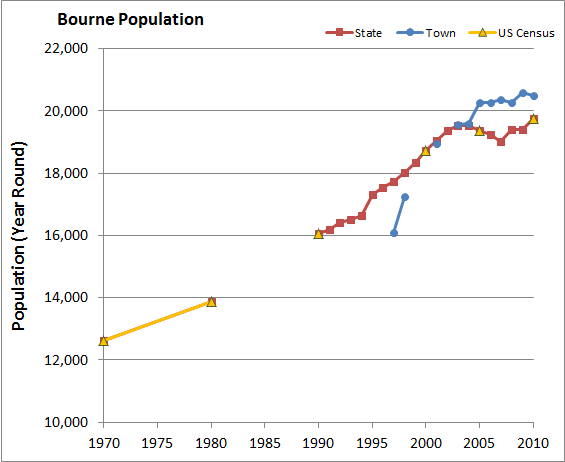Using US Census Data for estimating watershed wastewater nitrogen loads
Supplemental data for the application of seasonal occupancy statistics to US Census data to estimate average annualized water use and wastewater loading in Massachusetts watersheds.
[This page is under construction. Additional data will be posted sometime in 2018.]
Related Pages: Related Pages: Nitrogen Loading Assumptions | Parcel Level Analysis | Wastewater Disposal (includes sewer maps) | Wastewater Timeline
What is on this page
On this page we provide summary information, links and data for US Census data for selected Buzzards Bay watershed municipalities, and various subwatersheds in Southeastern Massachusetts. These statistics are useful for predicting subwatershed populations and watershed wastewater discharges from septic systems for unsewered area, and is an alternative approach to the water use method. Related information can be found on our wastewater page (includes sewer maps) and wastewater timeline page.
Watershed delineations
Our analysis is based the July 2012 coastal subwatersheds coverage posted on our GIS data page. Most of the boundaries in this coverage are based on the most recently published GIS coverages adopted by the Massachusetts Estuaries Project when available. For other subwatersheds, we have used the most recent versions developed and adopted by the USGS and the Cape Cod Commission. Click on the map on at the lower right of this page to see the subwatershed delineations used. Read also the information on our page about changes in the watershed boundary, which also contains Cape Cod and Buzzards Bay subwatershed shapefiles at the bottom of the page.
Links and Related Reports
UMass Donahue Institute (2008). Survey of Cape Cod Second Homeowners
GIS Coverages
[To be posted]
Historical census data sources and reliability
Most municipalities conduct an annual census by mail card, often related to voter registration lists. Mailer surveys do not always have a good response response rate, and the methodologies used are not always transparent. The Massachusetts Department of Revenue reports annual municipal populations at www.mass.gov/dor/local-officials/municipal-databank-and-local-aid-unit/databank-reports-new.html, but these data are from the U.S. Census, which are estimates based on their models (methods described at https://www.census.gov/programs-surveys/popest/technical-documentation/methodology.html). Municipal estimates may not agree with state and U.S. Census counts, as illustrated by the figure to below.

Applying the annualized occupancy rate method to historical census information
Our seasonal occupancy and annualized occupancy rates for municipalities and watersheds in Southeastern Massachusetts was based on the vacancy rates and mean household size for occupied units reported for blocks in the 2010 U.S. Census. If using historical construction information derived from assessors databases as described on our Wastewater Timeline page, it is important to use vacancy rates and occupancy rates for occupied units (household size) from each Census and apply that information to the residential unit counts calculated from assessors data.If this data is not available annually, it should be interpolated from the U.S. Census data.